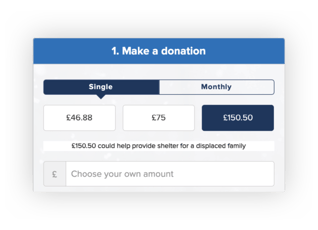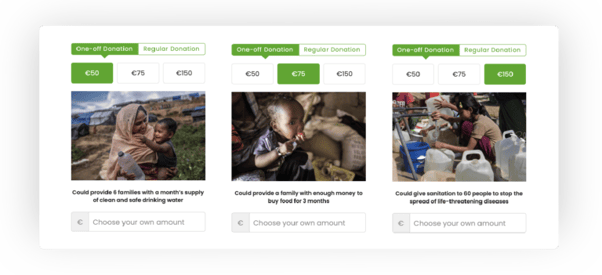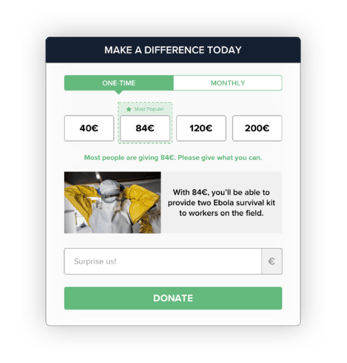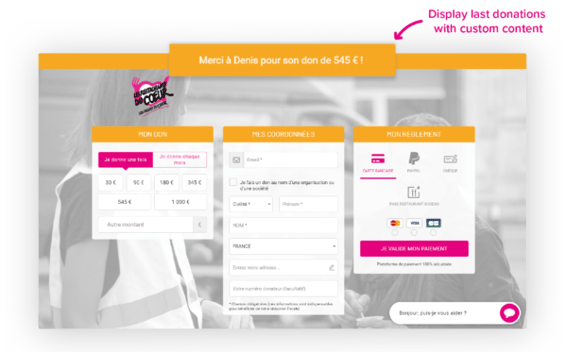When potential donors reach your online donation page, they have already answered the most important question “Should I give?”. This is a really good sign, you have made it through the hardest part. Then comes the second most important question: “How much should I give?”
While most people’s donations to charity are limited by their budget, there is always some room for you to convince them to contribute more. You can’t force your supporters to give a certain amount, but you’d be amazed how responsive people are to some tested tricks and tips.
In this article, we’ll cover 6 top tips to increase your average donations, explain how they work and how to incorporate them into your nonprofit marketing, website, donation forms, and even apply some of them to your off-line donation appeals, like fundraising events or door-to-door collections.
1. Set suggested donation amounts
 We are social creatures. We tend to make decisions based on the behaviour of the people around us. You can’t force your supporters to give a certain amount, but you’d be amazed to see how responsive people are to predetermined values.
We are social creatures. We tend to make decisions based on the behaviour of the people around us. You can’t force your supporters to give a certain amount, but you’d be amazed to see how responsive people are to predetermined values.
Suggested donation amounts serve two purposes:
- First, they improve the donation experience by reducing the number of choices your donors have to make. This makes them more likely to donate because the whole experience is easier.
- Second, suggested donations are opportunities for you to increase the donation amount. Donors are often willing to donate a bit more because they feel guided, and comfortable using the donation buttons displayed.
How to set suggested amounts on your donation pages? Suggest amounts that are relevant to your audience.
First, begin by reviewing your data. Let’s say you learn that last year, the average donation amount you received was €20. It wouldn’t make sense to request a €500 donation this year. Unrealistic requests like this would actually lower your participation rate rather than drive higher donations.
A great way to set suggested donations is to push amounts that are slightly higher than your previous average donation. For example, if the previous year's donation was €20, it would be smart to suggest donations of €5, €25, and €50. People who want to donate €20 would be more likely to increase their donation to €25 rather than reduce their donation all the way down to €5.
Put your preferred donation amount in the second position. On most fundraising pages, the preferred donation amount is usually the second option on the list. Why? People are naturally averse to spending, but they also don’t want to feel cheap.
Give them the option of giving a custom amount. Offering suggested amounts is a key way to collect donations and raise their values, but we shouldn’t forget about the people who want to donate something else. If there’s no option for them to enter a custom amount, they’ll probably just leave your donation page.
An interesting element for this last item to keep in mind, is that during emergency appeals, custom amounts usually record higher amounts than suggested ones.
2. Highlight equivalences
From a donor perspective, understanding the concrete impact of different donation amounts isn’t easy. A donor may ask themselves, “Does an additional €5 to my usual €20 gift really make a difference? Donors need to be able to literally “picture” the difference.
By using equivalences in your donation form you’ll make the donation more concrete. Donors will be able to see the impact of the different donation amounts you’re proposing. And by using terms like “€60 could give sanitation to 60 people to stop the spread of life-threatening diseases” you can still decide how you’ll use the money.
Here’s a good example by Oxfam Ireland:

3. Most popular amount widget.
 As explained at the beginning of this article, we feel comfortable when we think we’re conforming to the group.
As explained at the beginning of this article, we feel comfortable when we think we’re conforming to the group.
That is why we launched our “Most Popular Amount” widget at iRaiser, accessible to all donation form templates.
Thanks to this widget, you are able to nudge even more people to select your preferred amount by highlighting a specific one, and showing in a short sentence that this amount is the one most selected by donors like them.
4. Pre-filled donation amount based on the last donation
Because you know your supporters and the amount they have donated before to your organisation, you have in your hand the most powerful data to slightly increase their next donations. 
To put it simply: if a donor gave to charity €100 during your last December campaign, it can be assumed that they could give the same amount this year. What if you could ask them to donate a bit more? Imagine if you could increase by 5% all the donations you received last year, it would have a huge impact on your global budget!
Thanks to iRaiser’s URL builder tool, you can customise your next CTA with a personalized URL, based on donor data. You just have to create a file with donor information (first name, last name, email, address, etc.) and the amount of the last donation.
Using this tool, you’ll be able to automatically generate a unique URL that will drive to a donation form with a donation grid where new amount propositions will be slightly increased. You are also able to define by how much percentage you would like the amounts to be increased. And of course, all personal information is pre-filled to ease the whole process.
5. Use the right words
There are a few subtle changes that could encourage donors to make a higher donation. Specific words are one of them. Here are four words that can increase donations:
“Small”: Nonprofits can use this word when optimizing their marketing in two ways.
- To help people see their donation as a minor gift as opposed to a major sacrifice. In your opinion, which sounds like a more manageable ask: “a €5 fee” or “a small €5 fee”? Even if we know the fee is the same amount of money, the second phrase makes the fee sound even more reasonable.
- To demonstrate that even a small amount makes a difference. Make sure that potential donors know how much your organisation values every donation, no matter the amount. Example: “A small €10 donation will feed a child for an entire week.”
“Immediately”: Using the words “instantly” or “immediately” is a simple way marketers have found to increase conversions. Emphasize that donors can take action right now. Make sure to follow through (for instant gratification) by delivering, at least, a thank you email for the donation. That way the donor not only gets a special message, but they also get the assurance that their gift will be an immediate help to your cause.
“You”: To make a CTA (Call to Action) feel more personal without sounding fake or automated, use the word “you” instead of nothing or even a name. For example, write “You can make a difference today” instead of “Simon, make a difference today”, or “Make a difference today!”.
“Because”: If you want someone to do something for you, it helps to offer them a valid, or even obvious, reason to do it. Fortunately, you already have a good reason for the request you’re making, and you can use it in your CTA. Try to incorporate the word “because” along with a simplified reason into your appeal to remind your audience that their donation serves a great purpose. Example: “Donate to our emergency programs because the hungry can’t wait.”
6. “Last donations banner” widget
Once again, showing what others are giving is a great way to inspire your supporters. Thanks to our “Last Donations Banner” widget you are able to show the last 20 donations people gave with live and real data, directly on the top of your form.
Of course, you can set a minimum donation amount to display to encourage higher donations. You can see an example of a French organisation using this widget just below.

Visit the live version of this form here so you can see the widget in action.
Ready to increase donations on your website? With iRaiser’s fundraising solution, you can easily set up one (or hundreds!) of efficient donation forms and focus on what you do best: tell stories about your cause, inspire your supporters, and raise funds.
So, are you ready to increase your average donation? Also looking for a way to optimize your mobile fundraising? Check out iRaiser's article: 5 steps to optimize your mobile fundraising strategy.
